Country Footy Living Legends: The best of the bush
Meet some of the countless star players who excited the country footy fans of yesteryear with their brilliant on-field talents, and who are still talked about today.
In every country football league there have been countless star players who have excited fans with their brilliant on-field talents, which are still talked about today.
Their marvellous deeds, in leagues big and small, are forever etched into the memory bank.
Many have led clubs to the ultimate glory of premiership success.
But some have missed out on the thrill of raising the cup in September and still been a champion player for their club.
Sadly, some of the very best country footballers have passed.
But to honour all champions of yesteryear, The Weekly Times has scoured the state to find the very best players who are still alive.
The criteria for selection was simple for our Living Legends.
A player had to be a champion of the league they played in, have not played for a minimum 20 years and their achievements at VFL and AFL level carried no weight in the selection process.
These 20 players are truly the “Best of the Bush”.
ROB WALKER
(Wangaratta Rovers)
Laurie Burt had a front-row seat to the brilliance of Robbie Walker for the bulk of his legendary career with Wangaratta Rovers.
He was in his second season as Rovers coach in 1998 when he orchestrated an against-the-odds Ovens and Murray premiership win with a group of highly talented youngsters, led by Walker, who would be the foundation stone of more success.
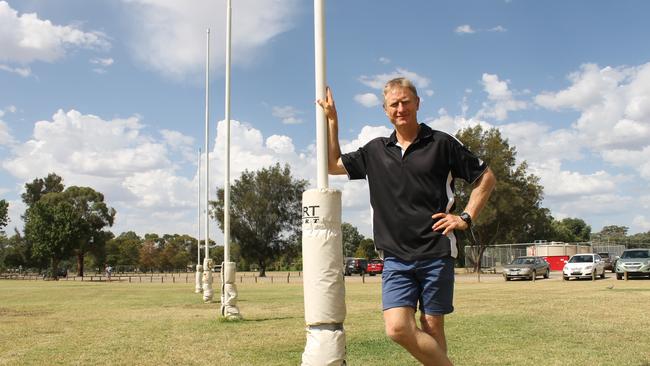
Walker initially played at centre half-forward, many say the hardest position on the ground, and simply dominated.
Burt said Walker was the fittest and most driven player of a star-studded team that went on to win further flags in 1991 and 1993-94.
“He was full bore at everything he did,” Burt said.
“There would be times when he’d had 28 kicks, taken 15 marks and kicked five or six goals on the Saturday and the next week at training, guess who would be running sprints up and down the ground before everyone else had even started?
“He saw his game as not being as good as it should have been, and to get better, he felt he had to do extra.”
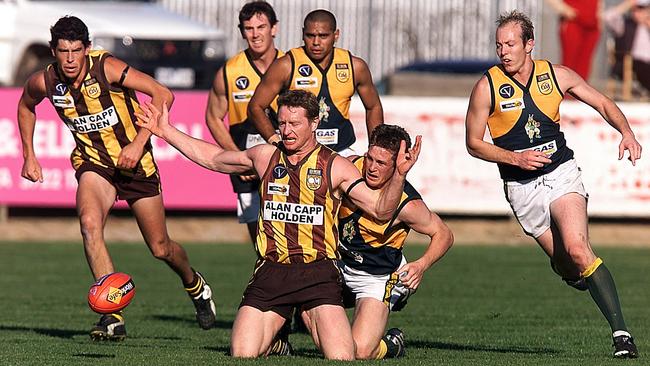
Walker won his first Morris Medal in 1991 with 31 votes, 13 clear of the runner-up, and always fired in September.
“Just about every grand final we played in, Rob was our best,” Burt said.
“He was a Dusty Martin type in finals.”
Walker transformed into a midfielder who was impossible for rivals to stop in the mid-1990s and his other four league medals came in his new on-field role, including his final season in 2003 when serious neck and back injuries forced him into sudden retirement.
“Centre half-forward is a hard position to play and he was scragged by two or three players at once,” Burt said.
“All the opposition’s plans revolved around stopping Rob.”
NEVILLE HOGAN
(Wangaratta Rovers)
Hogan, an official legend of the Ovens and Murray league, won the first of four club best and fairests in 1963.
He was a key cog in the 1964-65 flags and the next year he won the league’s Morris Medal.

The Rovers broke with tradition when it chose Hogan as an in-house coaching appointment after the blueprint of success had been established by VFL stars Bob Rose and Ken Boyd.
It proved a masterstroke as he led the club to flags in 1971, 1972, 1974 and 1975 while remaining a star player.
Hogan’s crowning glory as a player came in the 1971 grand final when he lined up in the forward pocket and kicked six goals.
DES CAMPBELL
(Shepparton United, Tongala, Kyabram)
Goulburn Valley league superstar who played in a premiership with Shepparton United in his first season in 1967.
Following a brief stint at Melbourne, Campbell was appointed United’s youngest coach in 1973 and led the club to the 1974 flag with an unforgettably dominant finals series.
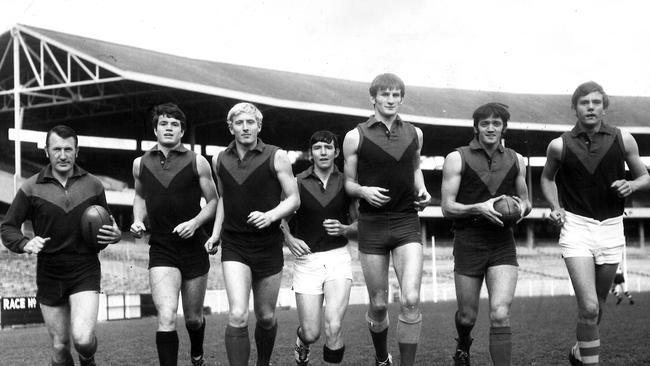
In 169 matches for United, Campbell won the club’s best and fairest three times, 1968-69 and 1971, and coached the club to another flag in 1980.
Also coached Tongala to back-to-back flags in 1983-84 followed by a stint at Kyabram.
TONY SOUTHCOMBE
(Golden Square, Boort, Northern United)
Big time player who played in eight Bendigo league premierships, four at both Golden Square and Northern United.
Southcombe coached five of those flags and was the dominant ruckman of his era, winning the Michelsen Medal in 1972 with a whopping 33 votes and another three years later.

Played briefly at Carlton before returning to Golden Square to play in its 1979 flag followed by a stint with Boort that also met with premiership glory.
Northern United was his final destination, leading the club to three successive flags as coach before playing in a fourth.
PHILLIP MORGAN
(Colbinabbin, Golden Square, Shepparton United, Rochester)
Burst onto the scene for Colbinabbin in 1982 and won best and fairests in his first three seasons.
After one year with Golden Square in 1985, Morgan returned to Colbinabbin and won the first of two Cheatley Medals.

Morgan joined Shepparton United in 1988 and played in two flags before again returning to Colbinabbin, taking over as coach and leading the club to the 1991 premiership.
Morgan had another stint in the GV with Rochester where he won the Morrison Medal.
Again he returned home and finished up playing in five flags with Colbinabbin before hanging up the boots in 2003.
PETER BROWN
(North Ballarat)
Ultimate big occasion player who joined the Ballarat league powerhouse in 1977 after playing for South Melbourne and starred when it mattered most for a decade.
Seven-time premiership player who won a best and fairest in the flag-winning year of 1982 and was runner-up twice in 1979 and 1981.
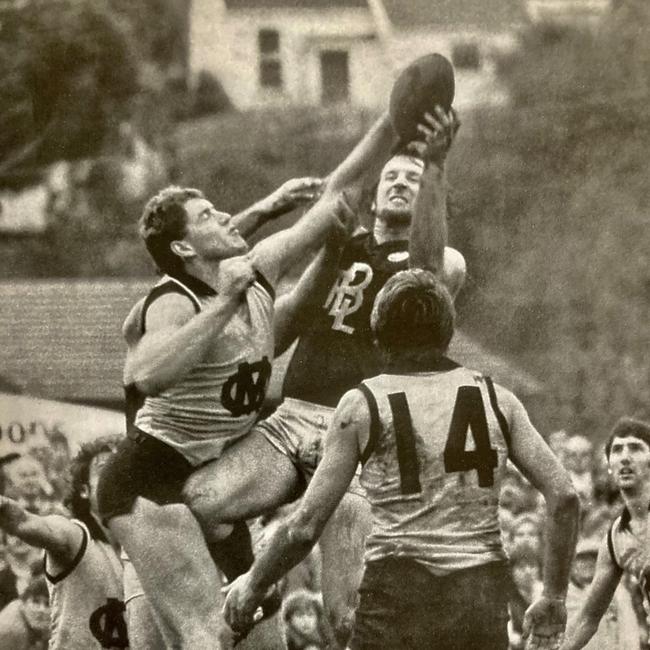
Brown also played in the era when the Ballarat league was the undisputed king of country footy, winning three successive country championships under John Northey.
Brown played in the ruck in all three championship wins, representing the BFL on 23 occasions.
MICK GIDDINGS
(Narraport, Wycheproof-Narraport)
Offers to try out with VFL clubs arrived in Mick Giddings’ mailbox every summer with the regularity of a Mallee scorcher.
Collingwood, Geelong, South Melbourne, Essendon and Footscray all tried and failed to lure the North Central league legend south to play in the big league.
The closest he came to accepting an offer to head to the VFL was a practice match with the Magpies.
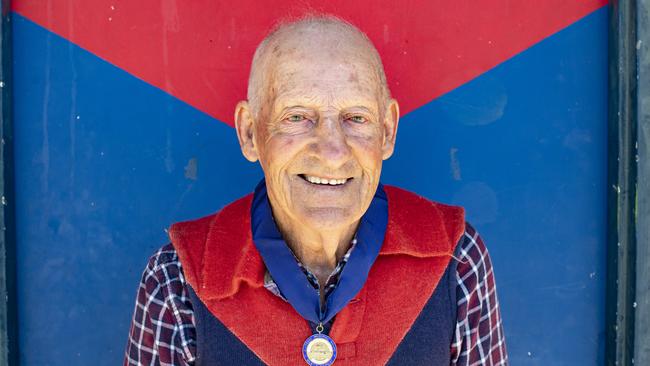
But Giddings stayed put, content to work on the family’s wheat and wool property south of Wycheproof, and play firstly for Narraport and then Wycheproof-Narraport when the two clubs merged in 1964.
“I was quite happy playing around here,” he said.
“We had the farm, that was a full-time job.
“You started playing in the seconds with all the old stagers, who knew every trick in the book.
“It was a good learning curve.
“I soon learnt you had to be fit, quick and know where the ball is going.
“I was pretty fortunate because on the farm you were throwing bags of wheat around, superphosphate, everything was done by hand.”
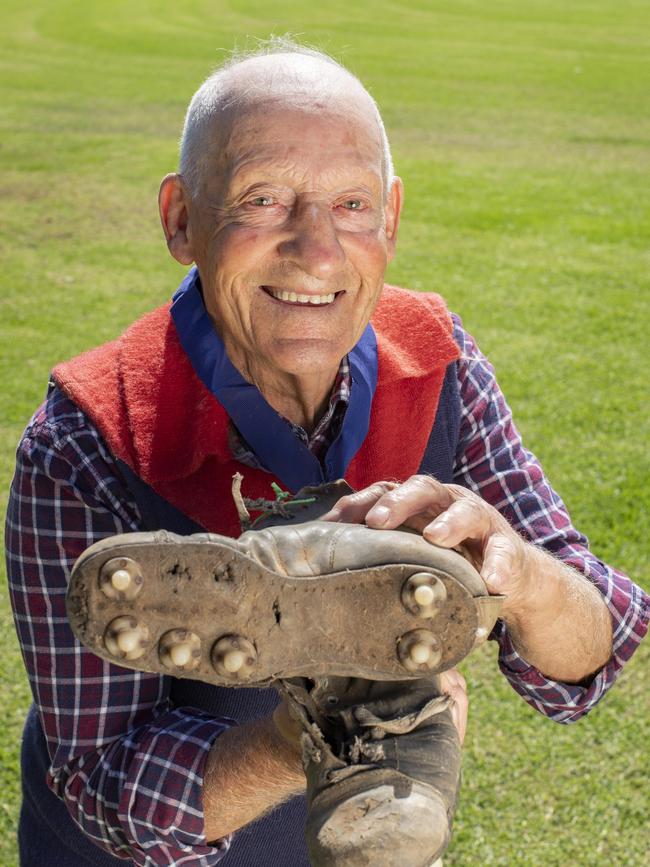
In the absence of junior grades in the North Central league, Giddings first played for Narraport in 1954 as a 15-year-old and was a member of the club’s premiership team two years later.
In 1958, Giddings established himself as one of the stars of the league by winning the first of a record four Feeny Medals as a dominant centreman.
His other medal-winning seasons were 1960-61 and 1966 with a runner-up finish in 1962.
Giddings was coach of Narraport when the merger with Wycheproof took place.
“The Combine” savoured instant premiership success in 1964 with Giddings playing in four flag-winning teams.
He also won five club best and fairests before eventually retiring in 1974 after playing more than 300 matches.
“The premierships were all good, but I still think about the two we lost,” he said.
RICHIE KALMS
(Murrayville, Dimboola, Swan Hill)
Three-time winner of the Mallee league best and fairest with his first being in 1964, after returning from a short stint at Essendon to play in a flag for Murrayville a year earlier.
A booming left foot kick, Kalms once kicked 10 goals in the final quarter of a match on his way to kicking 19 against Patchewollock.
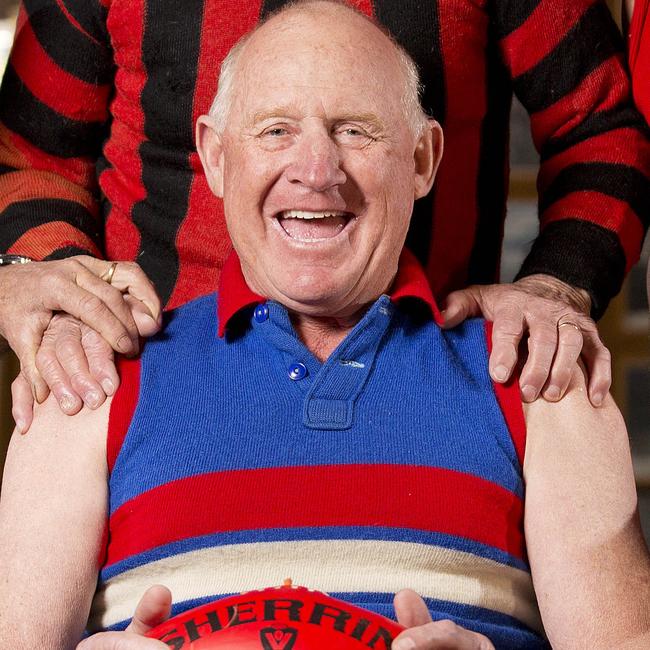
After further league best and fairests in 1969-70 and more premiership success with Murrayville, Kalms joined Dimboola and kicked 100 goals in the Wimmera league.
Also played with Swan Hill where he topped the league goal kicking and played in another flag.
JOHN LAPPIN
(Chiltern, Wodonga, Brocklesby)
A member of the famous Lappin clan from Chiltern who played in five premierships, the first in 1968, aged 16, when he booted four goals from a forward pocket.
Lappin won the first of three Ovens and King league Baker Medals in 1974, but three years earlier he topped the count only to be ruled ineligible.
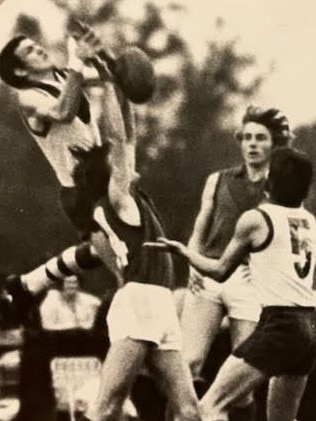
In addition to his other medal wins in 1978 and 1982, Lappin finished runner-up four times.
He also won the Hume league Azzi Medal in 1976 when he made a mid-season switch to Brocklesby where his brother Jock was coaching.
GARY COOPER
(Tatura, Mt Gambier, Shepparton United, Mooroopna)
“Mr Magic” of the Goulburn Valley league in the late 1970s and 1980s, Cooper won the first of three Morrison Medals with Tatura in 1977 before finishing runner-up the next year.
Often the first player picked for GV interleague teams, he helped the league to country championships glory in 1978 and after two years playing at Mt Gambier he returned to the GV and joined Shepparton United.
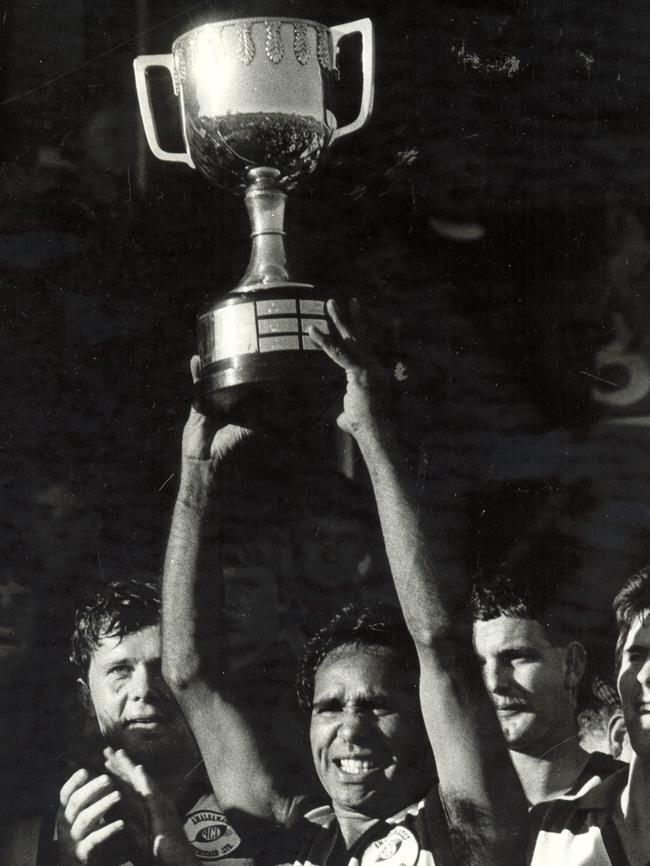
He spent only one season with United before crossing to Mooroopna where he won his second Morrison Medal.
In 1985 he won his third medal and also was best-on-ground in Mooroopna’s flag win.
Previously held the GV games record with 322 matches and also played 23 interleague games.
DICK O’BREE
(Lake Boga, Euroa)
Aged only 16, O’Bree booted 140 goals in his second senior season to help Lake Boga to a premiership.
Spent one more season in the Mid Murray league and kicked 92 goals in another flag-winning year before joining Euroa.

Following a brief stint at Collingwood, O’Bree returned to Euroa where he coached the club to seven flags and played in another between 1957 and 1971.
The 1971 flag was particularly significant, the club’s first in the Goulburn Valley league.
Booted 1285 goals in his brilliant career.
JOHN GALLUS
(Maffra, Bairnsdale, Warragul, Drouin, Warragul Industrials)
Has the rare distinction of winning three Latrobe Valley league Trood Award and Rodda Medals with three different clubs.
Initially played for Maffra and won the club’s best and fairest in 1968 before a teacher transfer east saw him join Bairnsdale where he won his first league medal with a record 37 votes, the following season.
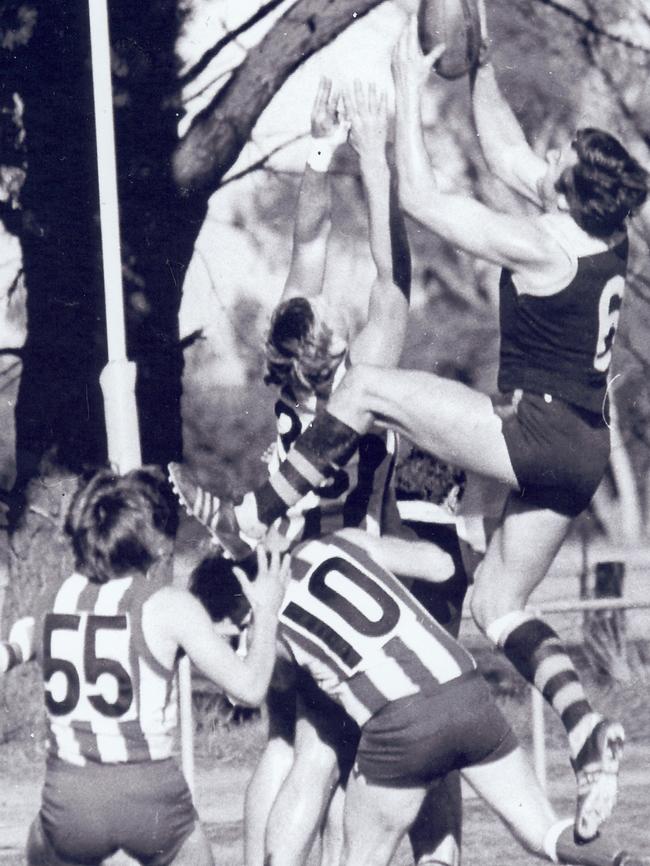
Back at Maffra after another work move, Gallus won his second medal and Maffra’s best and fairest again in 1970, triggering another stint with Melbourne in the VFL.
In 1974, Gallus was back in the LVFL with Warragul, which won the flag, and Gallus a dominant force.
Warragul made the grand final again and lost in 1975, but Gallus claimed a third medal.
TONY RUSSELL
(Hamilton, South Warrnambool, South Rovers, Caramut, Koroit, Port Fairy, Deakin University)
Burst onto the scene when he kicked a century of goals for Hamilton in the Western Border league in 1980.
A knee injury halted his time at VFL level with Collingwood and upon his return to the southwest, Russell and joined South Warrnambool where he played in three premierships between 1990 and 1994 and kicked the bulk of his goals in the Hampden league.

He had one season with South Rovers in 1993 and kicked 165 goals before heading back to South.
In 1995, he played for Caramut and kicked 171 goals before joining Koroit.
Was appointed coach of Port Fairy and brought up his 1000th career goal with the club on his way to a record 1020 in the HFL.
JOHN HOTKER
(Minyip, Minyip-Murtoa)
Official legend of the Wimmera league, Hotker was the dominant forward of his era in a career spanning more than 300 games.
Played in five flags for Minyip and Minyip-Murtoa after the two clubs merged in 1994 and was judged best-on-ground in the 1993 Minyip triumph.
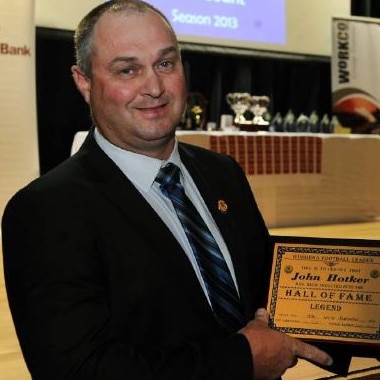
Topped the Wimmera league goal kicking award nine times with 143 goals being his season best haul.
Deadly accurate in front of goal, Hotker booted more than 1700 career goals.
TONY BECK
(Stawell, Navarre, Murtoa)
Undisputed star of the Wimmera league with his record five wins in the Toohey Medal.
First played for Stawell in 1976 and was an absolute standout player through the 1980s.
Won medals in 1980-81 and followed up with another win in 1983.
Again went back-to-back in 1986-87 after finishing runner-up the previous two years.
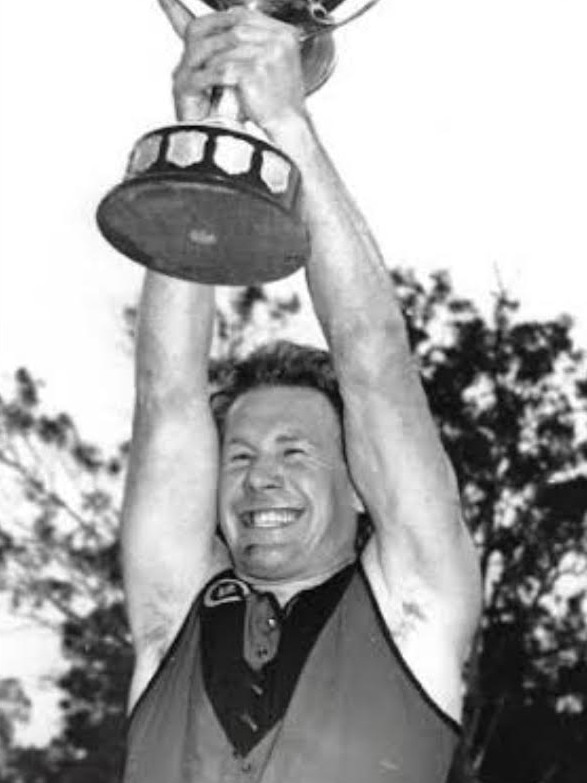
The 1987 season was a high point as he coached Stawell to the premiership and also represented the Wimmera league 23 times.
Played 265 matches for Stawell and is also a premiership player at Navarre in 1990 before heading back to Stawell.
GARRY VOSS
(Orbost, Snowy Rovers)
A ferocious rivalry existed between Orbost and Snowy Rovers for three decades and Voss made a sizeable contribution with both before they merged.
Initially Voss played at Orbost where he finished his career as a five-time premiership coach.
When Snowy Rovers were formed in 1970 he became the inaugural coach and led from the front in its formative years.
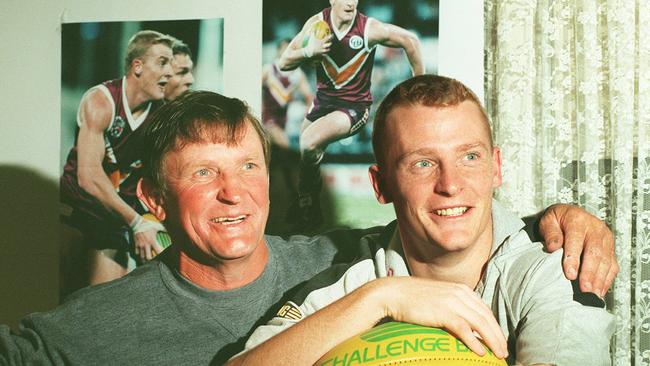
Won a hat-trick of Gippsland league best and fairests from 1971 playing in the ruck and coached Snowy Rovers to four flags with the first being in 1973 followed by three in a row from 1976.
Returned to Orbost in 1981 and coached it to a flag.
Father of Brisbane champion and current Carlton coach Michael.
JEFF GIESCHEN
(Maffra, Wodonga)
A champion schoolboy player, Gieschen quickly made his mark at senior level with Maffra when he won the first of seven club best and fairests at age of 15 in 1972.
He won club best and fairests either side of a four-year stint at Footscray and won two Trood Award and Rodda Medals in 1979 and 1982 on his return from the VFL.

Gieschen represented the Latrobe Valley at interleague level 15 times at a time when the competition was widely regarded as the strongest in the state.
Appointed coach of Wodonga and won the club’s best and fairest in his only season as a player, 1986, before coaching the club to flags in 1987 and 1990.
Later coached Richmond at AFL level.
JIM SANDRAL
(Corowa, Rennie)
The prospect of a long career with the dominant VFL team of the time couldn’t keep Jim Sandral in the city for more than two years.
Described by The Herald’s legendary football scribe Alf Brown as the “most sought after country footballer for many years”, Sandral was swayed to leave the family farm north of Corowa to play for Melbourne in 1956.
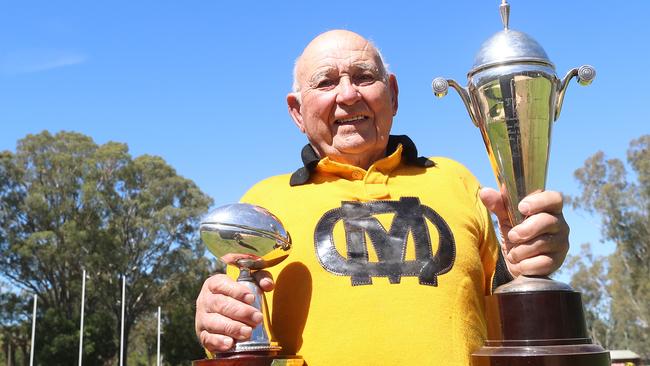
The previous year the Demons thought so highly of Sandral they flew him to Melbourne from Corowa on a small plane just to train.
Sandral forced his way into the powerful Melbourne line-up to play in the 1956 premiership, but after narrowly missing out a year later, he headed home.
“My father had bought a farm in my name out where we lived,” he said.
“I was the eldest boy in the family, and if I have a property in my name, I should be home working to help pay for it.”
Corowa was the major beneficiary of Sandral’s decision to leave Melbourne.
It appointed him coach in 1958 and he won the first of three Morris Medals a year later.
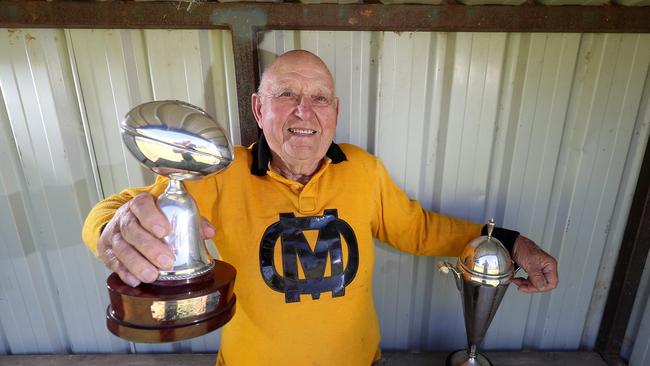
He won Corowa’s best and fairest five times with the closest he came to playing in a premiership being 1963 when it lost the grand final to Benalla.
“I enjoyed playing in the Ovens and Murray and we had a lot of coaches in the league who had played league football,” Sandral said.
“It was a really good, hard competition.”
Sandral, who turned 90 in February, was one of the first inductees into the O and M Hall of Fame when it started nearly 20 years ago and was elevated to legend status in 2013.
His son Dennis is also an O and M Hall of Famer after a similarly distinguished career for the club, which has sadly gone into recess this year.
BARRY PENDERGAST
(Benambra, Omeo)
A phenomenal career started when he first played for Benambra at the age of 14 in 1961.
Pendergast won 11 best and fairests for Benambra, but an even greater achievement was his nine Omeo and District league best player awards.
The first was in 1967 for Benambra and the last in 1983 with Omeo after switching clubs in 1981.
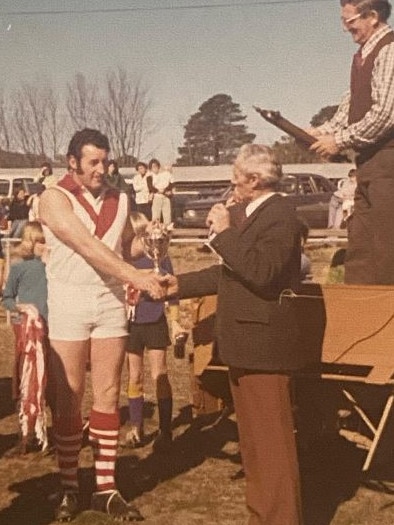
From 1971 the dominant ruckman of his era incredibly won seven league best and fairests in a row.
Pendergast’s first of six flags with Benambra was in his first season and he also played one with Omeo in 1986.
TREVOR SUTTON
(Deniliquin, Lake Boga, Robinvale, East Wagga)
Booted an Australian record 249 goals in an unforgettable Murray league 1982 season that also included winning the O’Dwyer Medal.
Sutton kicked 10 or more goals 13 times, broke the league record for most goals in a game with 21 against Coleambally and kicked another 20 in a match.

He broke the previous record for most goals in a season of 145 before the halfway mark of the year.
Deniliquin fell short of making the grand final with Sutton booting seven goals in the preliminary final loss to Cobram.
Also kicked more than 100 goals in the Mid Murray, Sunraysia and Riverina leagues.
JOHN RYAN
(Strathmerton)
A brilliant career with one club began aged 15 and ended when only 29 with a premiership in his last match.
Ryan was the dominant centre half-forward of his era and keenly sought after by VFL clubs including Melbourne and Collingwood, but resisted all overtures to stay loyal to Strathmerton.
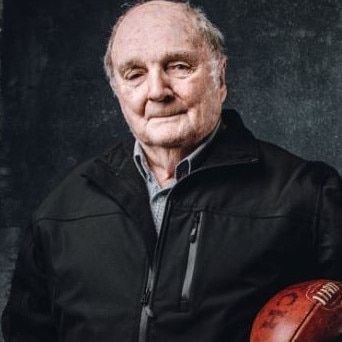
Played in his first premiership in 1956 and his second in his last career game in 1964.
Won a record fifth Murray league O’Dwyer Medal in his final season with his other successes coming the previous year and three in a row from 1957.
RAY WILLETT
(Rochester, Mooroopna, Corowa)
Originally from Melbourne, Willett headed to Rochester in 1962 for the first stop on what would be an outstanding career in three of the state’s strongest leagues.
Willett, who had played at full-forward for Collingwood in a VFL grand final, made an instant impression in the ruck by winning the Bendigo league’s Michelsen Medal in his first season.
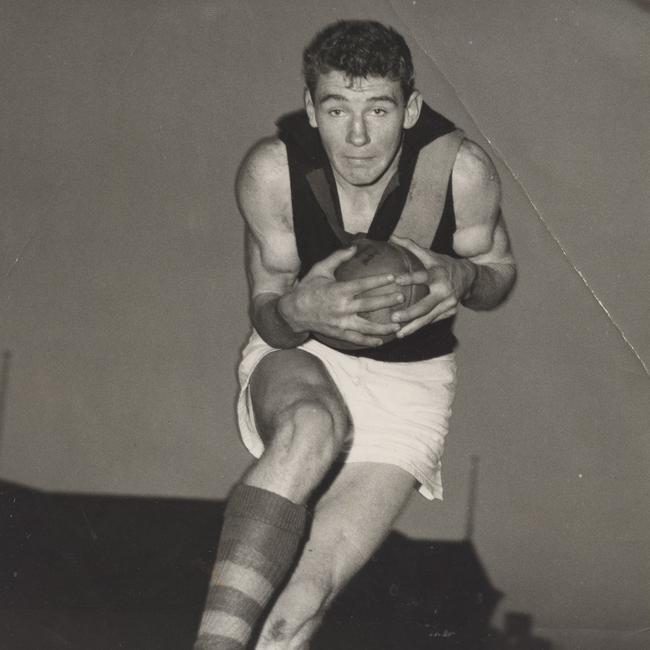
He also played in a flag for Rochester before a teacher transfer to the Goulburn Valley where he joined Mooroopna and won three Morrison Medals in 1965, 1967 and 1968.
Willett also played for Corowa and went within one vote of winning a third major league medal in 1972 by finishing runner-up to Myrtleford’s Bruce Waite.
Willett was inducted into the GV Hall of Fame in 2014.
To see our full list of the best country footy players since the year 2000, click here.




